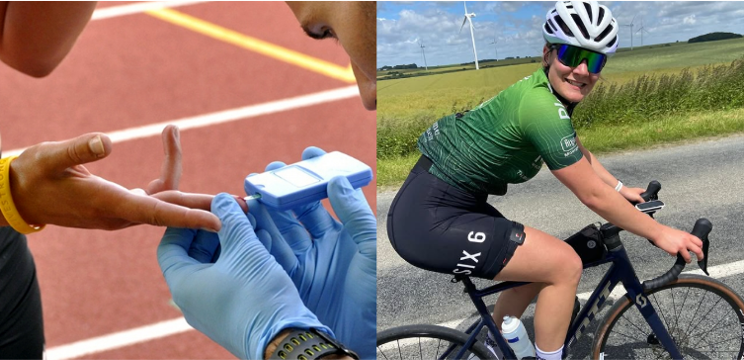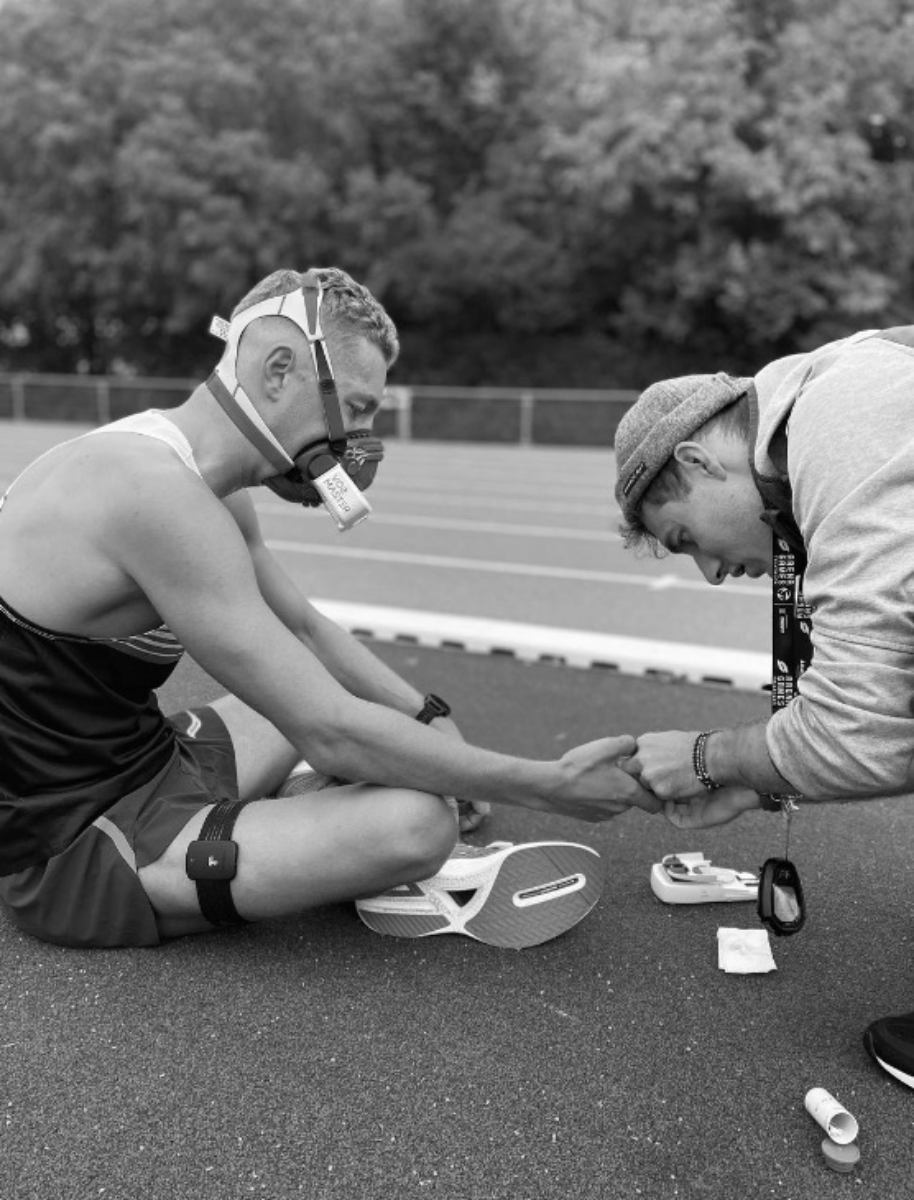Introduction: Lactate's Role in Training
For decades, lactate has been used for understanding exercise intensity and training adaptations. Lactate was long misunderstood as a "waste product" of anaerobic metabolism, however, recent research confirms that lactate is produced even at rest and during low-intensity exercise. This insight revolutionized its role in sports science, shifting our perspective to recognize lactate as a key metabolic intermediary.
When exercise intensity increases, lactate production exceeds the body’s ability to clear it through cardiac and skeletal muscle oxidation, leading to its accumulation in the blood. The point at which this imbalance occurs, known as the lactate threshold, has become fundamental for determining training intensity zones and enhancing athletic performance. There are typically, two thresholds mentioned in training, however, in this blog, we will refer to the second threshold (LT2) as the Lactate threshold.
Despite lactate's importance, its traditional measurement remains invasive and impractical in real-time settings. This limitation has raised interest in alternative approaches, such as non-invasive ways of measuring lactate as well as muscle oxygen saturation (SmO2), measured using near-infrared spectroscopy (NIRS).
The Role of Lactate in Training and Performance
Blood lactate levels have long been used to determine the intensity at which an athlete can perform sustainably. The lactate thresholds identify personalized training zones, helping coaches and athletes target the appropriate intensity for aerobic development while avoiding premature fatigue.
During intense exercise, energy production relies heavily on glycolysis, a rapid energy pathway that converts glucose into pyruvate. When energy demands are high, pyruvate is reduced to lactate to sustain ATP production, as oxidative pathways alone cannot keep up. If lactate accumulates faster than it is cleared, hydrogen ions (H+) are also released, contributing to fatigue and reduced exercise capacity .

Power and Lactate Threshold
The lactate threshold often occurs around a blood lactate concentration of 4 mM/L, which marks the transition between aerobic and anaerobic metabolism. However, this power value (in watts) is not consistent across individuals. Studies confirm that lactate threshold power varies significantly due to individual metabolic efficiency and lactate clearance capacity. Athletes who efficiently remove lactate exhibit better endurance performance and lower blood lactate accumulation at a given power output.
This variability highlights the importance of individualized lactate testing to prescribe training intensities effectively.
Real-Time Lactate Measurement: Challenges and Limitations
Despite its value in determining training zones, traditional blood lactate testing faces major limitations:
-
Invasive:
Blood samples require finger or ear pricks, disrupting training and causing discomfort. - Intermittent Data: Measurements are taken during pauses in exercise, providing only snapshots of lactate levels rather than continuous data.
- Impractical for Daily Use: Regular lactate testing is time-consuming, costly, and largely inaccessible to non-elite athletes.
In the last few years, emerging technologies such as sweat and interstitial fluid-based devices, have aimed to deliver non-invasive, continuous tracking of lactate levels. Nevertheless, these techniques do not seem to be accurate or stable enough yet to be used in the field.
Sweat-based sensors, for instance, are influenced by hydration levels and environmental factors, making their readings inconsistent. As a result, these technologies are not yet reliable or widespread. One approach is measuring lactate using sweat-based sensors. the relationship between sweat lactate and blood lactate is inconsistent, as sweat lactate concentrations can vary based on factors such as sweat rate, exercise intensity, and environmental conditions. This variability makes it challenging to derive accurate blood lactate levels or to provide actionable data during exercise.
Another approach is by using interstitial fluid sensors, which detect lactate in the fluid between cells via microneedles or thin filaments inserted just beneath the skin. These devices are still minimally invasive, requiring penetration of the skin, which may deter some users. Additionally, they face regulatory hurdles and significant engineering challenges to ensure precision and scalability.
Muscle Oxygen Saturation (SmO2): A Real-Time Alternative
While lactate testing remains the gold standard for determining metabolic thresholds, muscle oxygen saturation (SmO2) offers a non-invasive, real-time alternative. Devices using near-infrared spectroscopy (NIRS), such as the Train.Red sensors, measure the balance between oxygen delivery and consumption in the muscles. In other words, how effective the muscle is utilizing oxygen.
As we explained in the previous blog, Muscle Oxygen and Lactate measurements are two different energy systems that can in a certain way indirectly explain each other. Think of it like this: as one energy system in your body (which uses oxygen) gets overwhelmed and starts to slow down, another system (which doesn't rely on oxygen as much) takes over to keep you going. As exercise intensity increases, oxygen availability decreases, leading to a drop in Muscle Oxygen levels (%). With Muscle Oxygen you can see this change in real-time, without needing to take blood samples. In the Lactate threshold zone, there is a clear correlation between decreasing SmO2 levels and increasing blood lactate concentration
Comparing SmO2 and Lactate Threshold:
While SmO2 cannot directly replace lactate testing for pinpointing lactate threshold power, studies demonstrate its potential as an indirect indicator. For example:
- Lecuona Martínez et al. (2021) observed an average difference of 13W ± 18.5 between SmO2-based and lactate-based threshold power.
- In a similar study (Farzam, Starkweather et al., 2018), the difference was 21.4W, with the NIRS device providing results in under three minutes.
These findings suggest that SmO2 data, while not a perfect substitute for lactate testing, can reliably estimate training zones in a practical, non-invasive manner. The correlation between SmO2 levels and lactate threshold can vary based on the type of athlete because different athletes rely on specific energy systems and muscle fiber types during exercise.
1. Endurance Athletes (e.g., long-distance runners, cyclists)
- High Aerobic Capacity: Higher mitochondrial density (type II Fibers) muscles tend to have highly efficient oxygen delivery and utilization systems, so their SmO2 levels might decrease more gradually as the intensity rises.
- Delayed Shift to Anaerobic Energy: Their bodies are trained to stay in the aerobic zone for longer periods, meaning the drop in SmO2 correlates well with their slower lactate build-up.
- Stronger Correlation: SmO2 levels in these athletes are more closely aligned with lactate levels, making SmO2 a reliable predictor of their thresholds.
2. Power/Strength Athletes (e.g., sprinters, weightlifters)
- Lower Aerobic Emphasis: Higher amounts of fast switch fibers have less developed oxygen delivery systems and rely more on anaerobic energy production for short, high-intensity efforts.
-
Rapid SmO2 Drop:
SmO2 levels might fall more quickly with rising intensity due to limited oxygen utilization capacity. - Weaker Correlation: The rapid shift to anaerobic energy can lead to less precise correlations between SmO2 and lactate levels compared to endurance athletes.
3. Hybrid Athletes (e.g., Team Sports, Hyrox athletes)
- Balanced Energy System Use: These athletes rely on both aerobic and anaerobic systems depending on the demands of their sport.
- Variable SmO2 Behavior: Muscle Oxygen levels may show intermediate patterns, with fluctuations depending on the balance of energy system use during their specific training or events.
-
Moderate Correlation:
The mixed reliance on energy systems means Muscle Oxygen correlates well in most scenarios.
Endurance Profile:
Power Profile:

Implications for Training
Athlete type influences how SmO2 data is interpreted:
- Endurance athletes might use Muscle Oxygen as a direct proxy for lactate threshold and training zones.
- Power athletes might focus more on monitoring fatigue or recovery rather than precise thresholds.
- Hybrid athletes could use SmO2 trends to adapt training for the specific demands of their sport, both training zones as well as fatigue and recovery monitoring
Conclusion
Lactate threshold testing has been a cornerstone of endurance training, providing invaluable insights into individual performance limits and metabolic efficiency. However, the invasive and impractical nature of blood lactate measurement limits its real-world application.
Muscle Oxygen saturation measured via NIRS devices such as the Train.Red, emerges as a promising alternative. By providing real-time, non-invasive feedback on muscle oxygen dynamics, SmO2 monitoring offers athletes a practical way to optimize training intensity and recovery. While it cannot yet replace blood lactate testing for precision threshold measurements, its correlation with lactate kinetics makes it a reliable tool for identifying training zones.
As technology continues to advance, Muscle Oxygen monitoring may soon become the preferred method for endurance athletes seeking real-time performance data. Its ease of use, accuracy, and cost-effectiveness position it as a game-changer in sports science, bridging the gap between laboratory testing and practical training solutions.
Based on:
Sendra-Pérez, C., Encarnacion-Martinez, A., Salvador-Palmer, R. et al. Profiles of muscle-specific oxygenation responses and thresholds during graded cycling incremental test. Eur J Appl Physiol (2024). https://doi.org/10.1007/s00421-024-05593-1P. Farzam, Z. Starkweather, and M. A. Franceschini, "Validation of a novel wearable technology to estimate oxygen saturation level and lactate threshold power in the exercising muscle," in Biophotonics Congress: Biomedical Optics Congress 2018 (Microscopy/Translational/Brain/OTS), OSA Technical Digest (Optica Publishing Group, 2018), paper JTu3A.23.
Perrey, S.; Quaresima, V.; Ferrari, M. Muscle Oximetry in Sports Science: An Updated Systematic Review. Sports Med. 2024, 54, 975–996.
Continuous Lactate Monitors Could Change Training Forever




